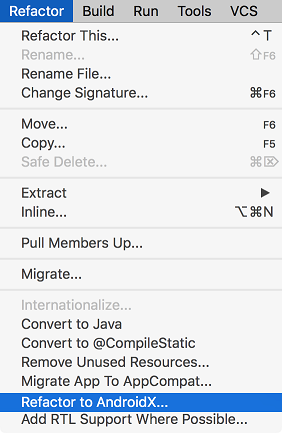AndroidX - Android Extension Library
From AndroidX documentation
We are rolling out a new package structure to make it clearer which
packages are bundled with the Android operating system, and which are
packaged with your app's APK. Going forward, the android.* package
hierarchy will be reserved for Android packages that ship with the
operating system. Other packages will be issued in the new androidx.*
package hierarchy as part of the AndroidX library.
Need of AndroidX
AndroidX is a redesigned library to make package names more clear. So from now on android hierarchy will be for only android default classes, which comes with android operating system and other library/dependencies will be part of androidx (makes more sense). So from now on all the new development will be updated in androidx.
com.android.support.** : androidx.
com.android.support:appcompat-v7 : androidx.appcompat:appcompat
com.android.support:recyclerview-v7 : androidx.recyclerview:recyclerview
com.android.support:design : com.google.android.material:material
Complete Artifact mappings for AndroidX packages
Previously, support library used the SDK version but AndroidX uses the Semantic-version. It’s going to re-version from 28.0.0 → 1.0.0.
How to migrate current project
In Android Studio 3.2 (September 2018), there is a direct option to migrate existing project to AndroidX. This refactor all packages automatically.
Before you migrate, it is strongly recommended to backup your project.
Existing project
- Android Studio > Refactor Menu > Migrate to AndroidX...
- It will analyze and will open Refractor window in bottom. Accept changes to be done.
![image]()
New project
Put these flags in your gradle.properties
android.enableJetifier=true
android.useAndroidX=true
Check @Library mappings for equal AndroidX package.
Check @Official page of Migrate to AndroidX
Bugs of migrating
- If you build app, and find some errors after migrating, then you need to fix those minor errors. You will not get stuck there, because that can be easily fixed.
- 3rd party libraries are not converted to AndroidX in directory, but they get converted at run time by Jetifier, so don't worry about compile time errors, your app will run perfectly.
Support 28.0.0 is last release?
From Android Support Revision 28.0.0
This will be the last feature release under the android.support
packaging, and developers are encouraged to migrate to AndroidX 1.0.0
So go with AndroidX, because Android will update only androidx package from now.
Further Reading
https://developer.android.com/topic/libraries/support-library/androidx-overview
https://android-developers.googleblog.com/2018/05/hello-world-androidx.html


androidx.*is package hierarchy for support libraries. They all will come uder same package as we comes to era ofandroidx(Like architecture components , other support libraries ). – Elledgeandroidxpackage from COREandroid. – Insightful